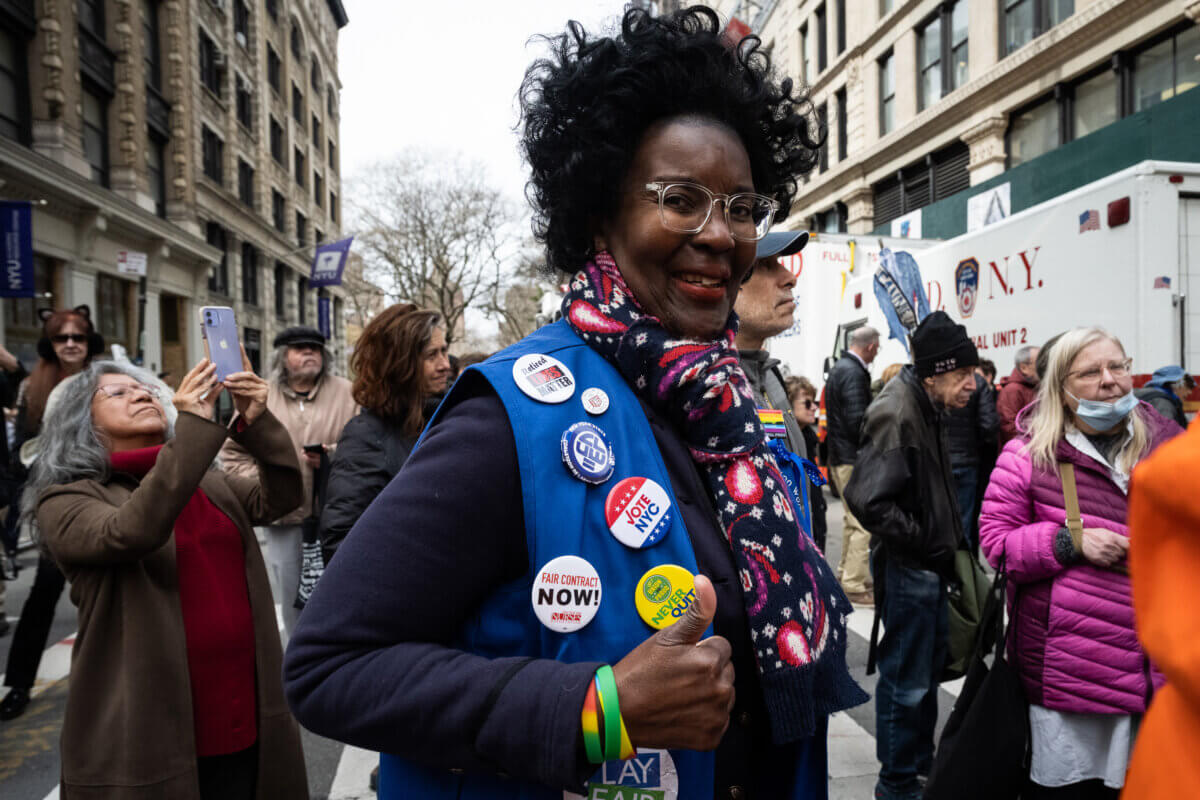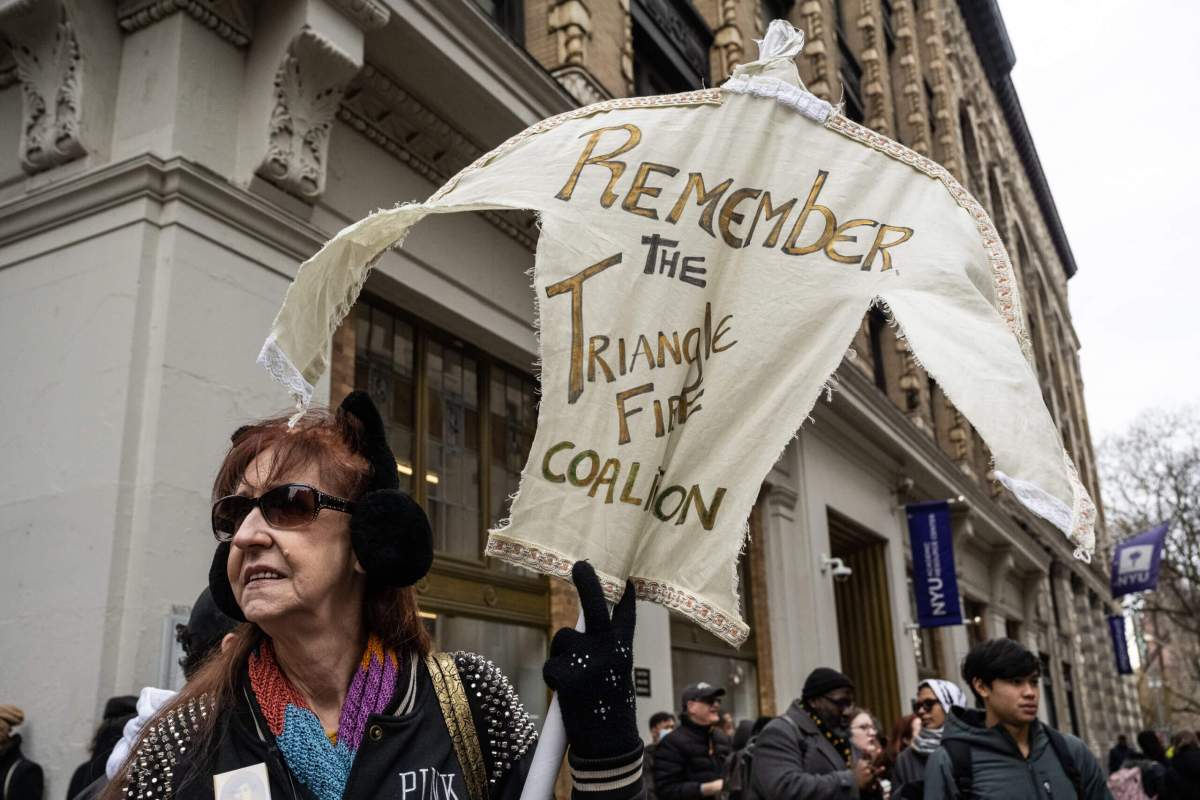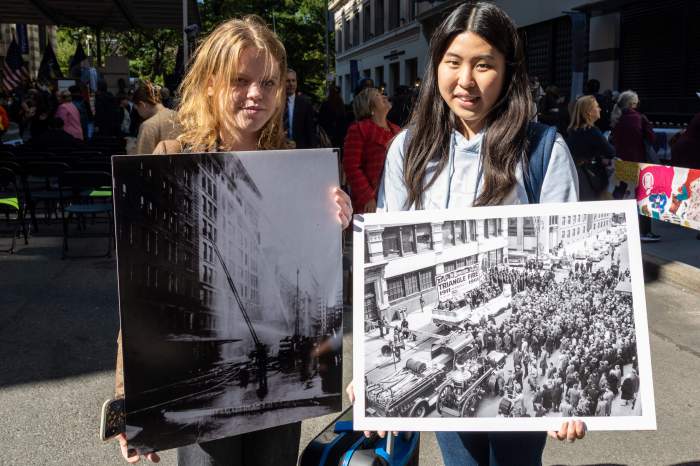New Yorkers, union members, and elected officials gathered outside the Asch Building on the corner of Washington Place and Greene Street in Greenwich Village on March 24 to remember the 146 victims of the Triangle Shirtwaist Factory Fire.
One of the deadliest blazes in city history, it also galvanized the labor movement and a series of reforms designed to prevent such a tragedy from happening again.
On March 24, 1911, a fire broke out in the Triangle Shirtwaist sweatshop, which occupied the eighth, ninth, and tenth floors of the Asch Building. The cause of the fire was a cigarette that had been carelessly thrown into a fabric scrap bin.
Water buckets, commonly used for extinguishing fires in garment factories, were empty. The victims, mostly girls and women, didn’t stand a chance to escape the inferno. One staircase had already been engulfed in flames while the door to another staircase was padlocked — back then, a common practice to prevent theft and unauthorized breaks.
The one fire escape quickly filled with workers but broke away from the building, and workers dropped 100 feet to their deaths. Other workers trapped inside the building chose to leap from their windows to their certain demise.
Firefighters could not extinguish the blaze since their ladders only reached the sixth floor. During the commemoration, members of FDNY Ladder 20 raised a ladder to the sixth floor to illustrate how limited the firefighting equipment was in 1911.



If it hadn’t been for the actions of one hero, the number of dead could have easily been much higher. Fannie Lansner, then a 21-year-old forewoman who had immigrated to the United States from Lithuania with her brother in 1907, ushered many of the sweatshop workers to safety.
About ten of Lansner’s descendants attended Friday’s memorial honoring their aunt. Erica Lansner described her aunt as “apparently very poised, very smart, very caring, and compassionate.”
“She got all the women out, and then at the end, she had no choice but to jump to her death,” Erica Lansner said. “Then there was a big front page article in the New York Evening Telegram that she was the heroine of the whole fire.”
Don Weiner shared that his great-aunt, 16-year-old Katie Weiner, was one of the last workers who made it out of the building alive.
“She slid down the elevator cable, eight floors, and landed on top of people’s heads,” Don Weiner said. “It was the only way to leave the building other than fly out the window.”
Katie’s sister, 20-year-old Rosie Weiner, perished in the fire.
“We’re here every year to make sure that people don’t forget,” Don Weiner said.



Descendants of the victims held up sashed blouses with the names of their relatives. Attendees placed white carnations with tags bearing the victims’ names at the corner of Washington Place and Greene Street while an FDNY firefighter tolled a bell each time the name of a victim was read.
The sweatshop owners Max Blanck and Isaac Harris were put on trial for manslaughter, but escaped prosecution. However, the horror of the fire sparked America’s labor movement, leading to stronger workplace safety regulations and fair wages.
Vinny Alvarez, president of the New York City Central Labor Council, said the fire was a defining moment in the history of labor.
“It taught us that workplace protection can never be passive,” Alvarez said. “We know that worker protection takes action, it takes advocacy, it takes education, and we need to stand together each and every day.”


Manhattan Borough President Mark Levine said the Triangle Shirtwaist Factory fire was a “crime scene.” He pointed out that, despite labor laws, many workers are still fighting for work safety and justice.
“There are workers fighting for safety in internet fulfillment warehouses. We support them. We support the Amazon Workers Union,” Levine said. “There are workers fighting for safety on construction sites. Too many jobs are still dangerous today in America. Our fight must continue.”
City Councilman Christopher Marte used the moment to highlight the exploitation of home attendants, and called on his colleagues in the City Council to stop ignoring their calls for fair treatment and pay.
“We are not only here for workers today. But we’re here for workers every day,” Marte said. “No matter who you are, no matter what you look like, and no matter where you work. If you stand with workers, you stand with everyone.”
Read more: Bronx Trucker Arrested for Trafficking Cocaine to NYC



































